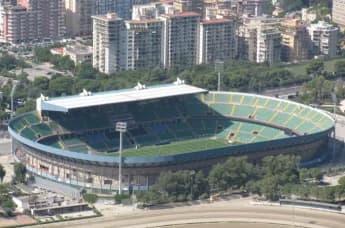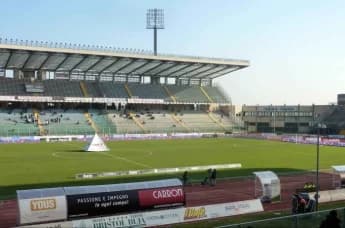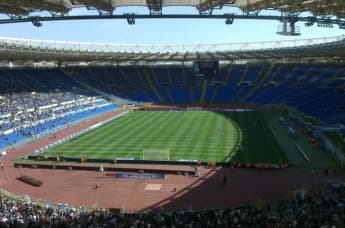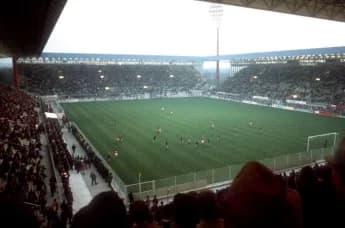The San Siro stands not only as Italy's largest stadium but as a global symbol of football culture, reflecting the passion and history of the game in Milan.
The San Siro, formally known as Stadio Giuseppe Meazza, transcends the definition of a football stadium; it is a worldwide emblem of sporting excellence and a key part of football's legacy. Located in the San Siro district of Milan, Italy, this legendary venue embodies the fervor that Milan has for the beautiful game. With the ability to seat 80,018 spectators, it stands as the largest stadium in Italy and is among the most renowned globally. It serves as the common ground for two footballing giants, AC Milan and Inter Milan, whose rivalry is one of the most passionate and historic in the sport’s annals. For nearly one hundred years, the San Siro has been a revered site where legends emerge, rivalries are stoked, and history is created.
This magnificent stadium is more than just a local gem; it stands as a worldwide symbol of football culture. Its grand structure, celebrated for its distinctive design and soaring red roof supports, commands the Milan skyline, attracting both fans and tourists. From the thunderous cheers of the crowd during Serie A games to the vibrant atmosphere of international events, the San Siro embodies the essence of football in its most authentic form.
Designated as a UEFA Category Four stadium, the San Siro has been the venue for some of football's most illustrious events. It has served as the backdrop for memorable UEFA Champions League finals, FIFA World Cup matches, and various other significant tournaments, reinforcing its status as a place that offers unforgettable experiences. For fans, being present at a match in the San Siro is a must-do experience. Its bowl-shaped structure provides outstanding views from every seat, and its acoustics enhance the sounds of cheers and chants, creating a vibrant atmosphere that echoes throughout the stands.
In addition to its impressive structure, the San Siro is a symbol of Milan’s heritage and identity. It represents the city’s vibrant cultural landscape and acts as a community hub for fans of all generations, connected by their passion for football. Whether it’s the intense Derby della Madonnina, where AC Milan competes against Inter Milan for dominance, or a crucial international match, the stadium becomes a vibrant showcase of emotion, reflecting the fervor and pride of its supporters.
The San Siro is more than just a football stadium; it stands as a testament to the sport itself. It has been the backdrop for numerous instances of victory and despair, becoming a treasure trove of memories for millions of fans around the globe. Its importance goes beyond geographical boundaries, turning it into a pilgrimage destination for football lovers who travel to Milan to feel its enchantment. As it progresses and adapts to the needs of contemporary football, the San Siro remains a lasting emblem of the sport's everlasting charm, solidifying its status as one of the most esteemed stadiums in the world.
Legendary Matches
The San Siro has hosted an array of iconic matches, securing its place in the annals of football history. Its revered pitch has been the backdrop for memorable contests that have significantly influenced the sport, establishing it as a beloved site for both fans and players.
One of the stadium's earliest unforgettable moments occurred during the 1934 FIFA World Cup, where it played host to three matches, including a thrilling semi-final between Italy and Austria. This event marked the start of the San Siro’s rise to prominence on the world stage. Many years later, the stadium gained even more recognition by hosting six games in the 1990 FIFA World Cup, featuring an exciting opening ceremony and group-stage matches that enthralled millions of fans globally.
The UEFA Champions League finals have significantly enhanced the San Siro’s reputation, hosting some of the most memorable nights in European football. In 1965, Inter Milan celebrated their victory by lifting the trophy on their own ground, a moment that is forever treasured by Nerazzurri fans. Another landmark occasion was the 2016 Champions League final, where Real Madrid faced Atlético Madrid in a thrilling penalty shootout, further establishing the stadium as a premier venue for the most significant events in football.
In the realm of domestic football, the Derby della Madonnina represents the intense rivalry between AC Milan and Inter Milan, giving rise to numerous unforgettable encounters. These electrifying matches have displayed stunning goals, intense moments, and an atmosphere of celebration that only the fervent supporters of Milan can create. Historic clashes, such as AC Milan's 6–0 rout in 2001 and Inter's convincing 4–0 win in 2009, are permanently inscribed in the history books of football.
The San Siro has been a venue for a variety of international matches. Notable moments include Italy’s 2–1 victory over Ukraine in the Euro 2024 qualifiers and their 3–1 win against England in the UEFA Nations League. These encounters, filled with excitement and passion, highlight the stadium's standing as a stronghold for exhilarating football events.
Amenities and Features
The architectural grandeur of the San Siro, along with its amenities designed for fans, distinguishes it as one of the top stadiums globally. Its distinctive design includes a bowl-shaped layout and soaring helical ramps, which provide effortless access to the upper levels while ensuring exceptional views of the field from every seat. The prominent red girders that support the roof contribute to its unique appearance, making the stadium instantly recognizable across the globe.
The stadium features an impressive seating capacity of 80,018, creating a vibrant atmosphere during matches. The acoustics enhance the cheers of the fans, resulting in an exhilarating environment that is truly unmatched. For spectators, the San Siro provides contemporary amenities, including roomy seating areas, high-quality restrooms, and various food and drink options that cater to a wide range of preferences.
A notable highlight of the stadium is its museum, which opened in 1996. This museum stands as a tribute to the histories of AC Milan and Inter Milan, featuring a vast array of historic jerseys, trophies, memorabilia, and artistic displays. Guests are invited to delve into the rich legacies of these footballing powerhouses, exploring their achievements and the players who have become legends.
Moreover, the San Siro offers VIP hospitality options, featuring opulent lounges and private boxes that provide exceptional views and unique experiences. These areas come with cutting-edge amenities, making them perfect for corporate functions or premium fan engagements.
The stadium places a strong emphasis on accessibility, featuring dedicated amenities for fans with disabilities, ensuring that everyone can experience the excitement of matchday. Additionally, for those attending with children, the family-friendly areas provide a secure and enjoyable atmosphere.
The fan experience at the San Siro is significantly enhanced by modern technology. The use of high-definition LED displays and a sophisticated sound system ensures that every replay and announcement is clear and audible, maintaining fan engagement throughout the event. Additionally, ample parking and efficient public transport options surrounding the stadium make it easy for both local and international visitors to access the venue without any hassle.
The San Siro melds tradition with contemporary design, fulfilling the demands of today's football enthusiasts while respecting its rich history. It is more than just a stadium; it stands as a symbol of football's lasting allure and serves as a guiding light for supporters globally.
Significance in History
The history of the San Siro is deeply connected to the development of football itself. The concept for the stadium originated in the early 1920s, with AC Milan’s president, Piero Pirelli, imagining a cutting-edge venue dedicated entirely to the sport. The chosen site, located in the San Siro district close to the horse racing track, was selected for its spaciousness and ease of access. Officially opened on September 19, 1926, the stadium held its inaugural match, showcasing a thrilling derby in which Inter Milan triumphed over AC Milan with a score of 6–3. Though it was a simple construction at that time, its immense potential was clear.
Originally owned by AC Milan, the stadium became a shared venue in 1947 when Inter Milan relocated from the Arena Civica. This development signified the start of a lasting bond between the two footballing powerhouses of the city, transforming San Siro into a representation of both rivalry and unity. Throughout the years, the stadium has seen extensive renovations to increase its capacity and enhance its facilities. A notable upgrade took place from 1948 to 1955 when engineers Armando Ronca and Ferruccio Calzolari devised a plan aimed at boosting its capacity to 150,000 spectators. Although the final design could accommodate 100,000 because of structural factors, this project affirmed San Siro's status as a venue capable of hosting large audiences.
In 1980, the stadium was officially renamed Stadio Giuseppe Meazza to pay tribute to one of Italy's most legendary footballers. Giuseppe Meazza, a two-time World Cup champion, played for both Inter and Milan, although he is most renowned for his time at Inter. Even after the name change, supporters from both teams commonly refer to the venue as San Siro, highlighting its strong ties to the district and its cultural significance.
The importance of San Siro goes beyond just club football. It has been the venue for significant matches in international competitions, including the FIFA World Cups held in 1934 and 1990, as well as the UEFA Euro 1980. Renovations carried out in preparation for the 1990 World Cup revamped the stadium, adding a third tier and its iconic red roof girders. This era signified the beginning of the stadium’s contemporary phase, merging modern design elements with its historical allure.
The establishment of an on-site museum in 1996 solidified the San Siro's reputation as a must-visit destination for football enthusiasts. Guests have the opportunity to delve into the vibrant histories of AC Milan and Inter, admire a range of trophies, and connect with the narratives of iconic players. Today, the San Siro stands as an essential component of football heritage, linking the sport’s past, present, and future.
Future Events
The future of San Siro shines as brightly as its remarkable history. The stadium is set to assume a crucial role in the 2026 Winter Olympics, where it will host the opening ceremony, highlighting its multifunctionality beyond just football. Furthermore, it is a leading candidate to stage matches during UEFA Euro 2032, likely attracting football enthusiasts from all over Europe once more. With a calendar filled with domestic matches, international friendlies, and club rivalries each year, San Siro continues to be a center of sporting excellence and cultural importance.
Fan Engagement
For supporters, experiencing San Siro is truly enchanting. The adventure starts with the breathtaking view of its magnificent exterior, featuring striking red girders and winding ramps. Once inside, the energy is palpable, driven by fervent fans singing and waving flags together. The concourses are filled with food vendors offering delicious Italian dishes, ranging from pizzas to gelato, ensuring that fans are satisfied and energized. The on-site museum provides a fascinating look into the history of Milanese football, creating an ideal pre-match atmosphere. With comfortable seating, effective crowd management, and a communal spirit that bridges rivalries, participating in a match or event at San Siro is a memorable experience that every football lover should treasure.
The San Siro, formally known as Stadio Giuseppe Meazza, transcends the definition of a football stadium; it is a worldwide emblem of sporting excellence and a key part of football's legacy. Located in the San Siro district of Milan, Italy, this legendary venue embodies the fervor that Milan has for the beautiful game. With the ability to seat 80,018 spectators, it stands as the largest stadium in Italy and is among the most renowned globally. It serves as the common ground for two footballing giants, AC Milan and Inter Milan, whose rivalry is one of the most passionate and historic in the sport’s annals. For nearly one hundred years, the San Siro has been a revered site where legends emerge, rivalries are stoked, and history is created.
This magnificent stadium is more than just a local gem; it stands as a worldwide symbol of football culture. Its grand structure, celebrated for its distinctive design and soaring red roof supports, commands the Milan skyline, attracting both fans and tourists. From the thunderous cheers of the crowd during Serie A games to the vibrant atmosphere of international events, the San Siro embodies the essence of football in its most authentic form.
Designated as a UEFA Category Four stadium, the San Siro has been the venue for some of football's most illustrious events. It has served as the backdrop for memorable UEFA Champions League finals, FIFA World Cup matches, and various other significant tournaments, reinforcing its status as a place that offers unforgettable experiences. For fans, being present at a match in the San Siro is a must-do experience. Its bowl-shaped structure provides outstanding views from every seat, and its acoustics enhance the sounds of cheers and chants, creating a vibrant atmosphere that echoes throughout the stands.
In addition to its impressive structure, the San Siro is a symbol of Milan’s heritage and identity. It represents the city’s vibrant cultural landscape and acts as a community hub for fans of all generations, connected by their passion for football. Whether it’s the intense Derby della Madonnina, where AC Milan competes against Inter Milan for dominance, or a crucial international match, the stadium becomes a vibrant showcase of emotion, reflecting the fervor and pride of its supporters.
The San Siro is more than just a football stadium; it stands as a testament to the sport itself. It has been the backdrop for numerous instances of victory and despair, becoming a treasure trove of memories for millions of fans around the globe. Its importance goes beyond geographical boundaries, turning it into a pilgrimage destination for football lovers who travel to Milan to feel its enchantment. As it progresses and adapts to the needs of contemporary football, the San Siro remains a lasting emblem of the sport's everlasting charm, solidifying its status as one of the most esteemed stadiums in the world.
Legendary Matches
The San Siro has hosted an array of iconic matches, securing its place in the annals of football history. Its revered pitch has been the backdrop for memorable contests that have significantly influenced the sport, establishing it as a beloved site for both fans and players.
One of the stadium's earliest unforgettable moments occurred during the 1934 FIFA World Cup, where it played host to three matches, including a thrilling semi-final between Italy and Austria. This event marked the start of the San Siro’s rise to prominence on the world stage. Many years later, the stadium gained even more recognition by hosting six games in the 1990 FIFA World Cup, featuring an exciting opening ceremony and group-stage matches that enthralled millions of fans globally.
The UEFA Champions League finals have significantly enhanced the San Siro’s reputation, hosting some of the most memorable nights in European football. In 1965, Inter Milan celebrated their victory by lifting the trophy on their own ground, a moment that is forever treasured by Nerazzurri fans. Another landmark occasion was the 2016 Champions League final, where Real Madrid faced Atlético Madrid in a thrilling penalty shootout, further establishing the stadium as a premier venue for the most significant events in football.
In the realm of domestic football, the Derby della Madonnina represents the intense rivalry between AC Milan and Inter Milan, giving rise to numerous unforgettable encounters. These electrifying matches have displayed stunning goals, intense moments, and an atmosphere of celebration that only the fervent supporters of Milan can create. Historic clashes, such as AC Milan's 6–0 rout in 2001 and Inter's convincing 4–0 win in 2009, are permanently inscribed in the history books of football.
The San Siro has been a venue for a variety of international matches. Notable moments include Italy’s 2–1 victory over Ukraine in the Euro 2024 qualifiers and their 3–1 win against England in the UEFA Nations League. These encounters, filled with excitement and passion, highlight the stadium's standing as a stronghold for exhilarating football events.
Amenities and Features
The architectural grandeur of the San Siro, along with its amenities designed for fans, distinguishes it as one of the top stadiums globally. Its distinctive design includes a bowl-shaped layout and soaring helical ramps, which provide effortless access to the upper levels while ensuring exceptional views of the field from every seat. The prominent red girders that support the roof contribute to its unique appearance, making the stadium instantly recognizable across the globe.
The stadium features an impressive seating capacity of 80,018, creating a vibrant atmosphere during matches. The acoustics enhance the cheers of the fans, resulting in an exhilarating environment that is truly unmatched. For spectators, the San Siro provides contemporary amenities, including roomy seating areas, high-quality restrooms, and various food and drink options that cater to a wide range of preferences.
A notable highlight of the stadium is its museum, which opened in 1996. This museum stands as a tribute to the histories of AC Milan and Inter Milan, featuring a vast array of historic jerseys, trophies, memorabilia, and artistic displays. Guests are invited to delve into the rich legacies of these footballing powerhouses, exploring their achievements and the players who have become legends.
Moreover, the San Siro offers VIP hospitality options, featuring opulent lounges and private boxes that provide exceptional views and unique experiences. These areas come with cutting-edge amenities, making them perfect for corporate functions or premium fan engagements.
The stadium places a strong emphasis on accessibility, featuring dedicated amenities for fans with disabilities, ensuring that everyone can experience the excitement of matchday. Additionally, for those attending with children, the family-friendly areas provide a secure and enjoyable atmosphere.
The fan experience at the San Siro is significantly enhanced by modern technology. The use of high-definition LED displays and a sophisticated sound system ensures that every replay and announcement is clear and audible, maintaining fan engagement throughout the event. Additionally, ample parking and efficient public transport options surrounding the stadium make it easy for both local and international visitors to access the venue without any hassle.
The San Siro melds tradition with contemporary design, fulfilling the demands of today's football enthusiasts while respecting its rich history. It is more than just a stadium; it stands as a symbol of football's lasting allure and serves as a guiding light for supporters globally.
Significance in History
The history of the San Siro is deeply connected to the development of football itself. The concept for the stadium originated in the early 1920s, with AC Milan’s president, Piero Pirelli, imagining a cutting-edge venue dedicated entirely to the sport. The chosen site, located in the San Siro district close to the horse racing track, was selected for its spaciousness and ease of access. Officially opened on September 19, 1926, the stadium held its inaugural match, showcasing a thrilling derby in which Inter Milan triumphed over AC Milan with a score of 6–3. Though it was a simple construction at that time, its immense potential was clear.
Originally owned by AC Milan, the stadium became a shared venue in 1947 when Inter Milan relocated from the Arena Civica. This development signified the start of a lasting bond between the two footballing powerhouses of the city, transforming San Siro into a representation of both rivalry and unity. Throughout the years, the stadium has seen extensive renovations to increase its capacity and enhance its facilities. A notable upgrade took place from 1948 to 1955 when engineers Armando Ronca and Ferruccio Calzolari devised a plan aimed at boosting its capacity to 150,000 spectators. Although the final design could accommodate 100,000 because of structural factors, this project affirmed San Siro's status as a venue capable of hosting large audiences.
In 1980, the stadium was officially renamed Stadio Giuseppe Meazza to pay tribute to one of Italy's most legendary footballers. Giuseppe Meazza, a two-time World Cup champion, played for both Inter and Milan, although he is most renowned for his time at Inter. Even after the name change, supporters from both teams commonly refer to the venue as San Siro, highlighting its strong ties to the district and its cultural significance.
The importance of San Siro goes beyond just club football. It has been the venue for significant matches in international competitions, including the FIFA World Cups held in 1934 and 1990, as well as the UEFA Euro 1980. Renovations carried out in preparation for the 1990 World Cup revamped the stadium, adding a third tier and its iconic red roof girders. This era signified the beginning of the stadium’s contemporary phase, merging modern design elements with its historical allure.
The establishment of an on-site museum in 1996 solidified the San Siro's reputation as a must-visit destination for football enthusiasts. Guests have the opportunity to delve into the vibrant histories of AC Milan and Inter, admire a range of trophies, and connect with the narratives of iconic players. Today, the San Siro stands as an essential component of football heritage, linking the sport’s past, present, and future.
Future Events
The future of San Siro shines as brightly as its remarkable history. The stadium is set to assume a crucial role in the 2026 Winter Olympics, where it will host the opening ceremony, highlighting its multifunctionality beyond just football. Furthermore, it is a leading candidate to stage matches during UEFA Euro 2032, likely attracting football enthusiasts from all over Europe once more. With a calendar filled with domestic matches, international friendlies, and club rivalries each year, San Siro continues to be a center of sporting excellence and cultural importance.
Fan Engagement
For supporters, experiencing San Siro is truly enchanting. The adventure starts with the breathtaking view of its magnificent exterior, featuring striking red girders and winding ramps. Once inside, the energy is palpable, driven by fervent fans singing and waving flags together. The concourses are filled with food vendors offering delicious Italian dishes, ranging from pizzas to gelato, ensuring that fans are satisfied and energized. The on-site museum provides a fascinating look into the history of Milanese football, creating an ideal pre-match atmosphere. With comfortable seating, effective crowd management, and a communal spirit that bridges rivalries, participating in a match or event at San Siro is a memorable experience that every football lover should treasure.







